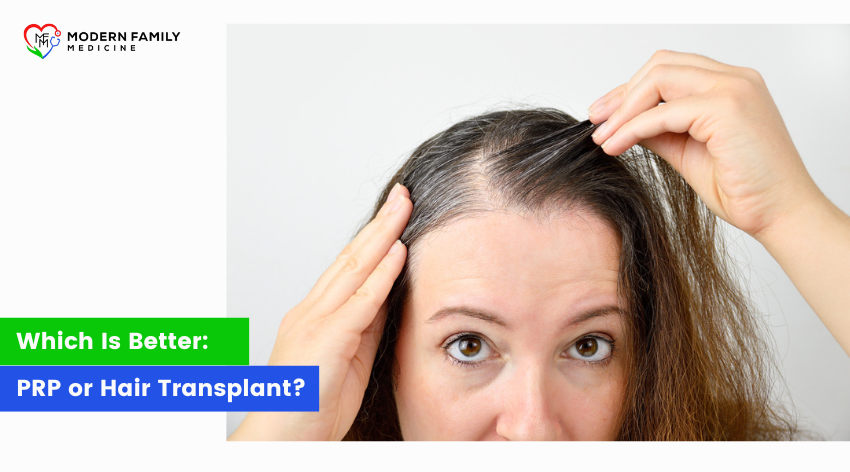



Hair loss is a widespread concern impacting self-esteem and confidence. Platelet-rich Plasma (PRP) therapy and hair transplants stand out as popular options for hair restoration. PRP therapy utilizes the patient's blood plasma to stimulate hair follicles, while hair transplants involve surgically relocating healthy follicles.
This blog aims to compare these methods, offering insights into their mechanisms, effectiveness, and suitability for individual needs. By providing comprehensive information, we assist readers in making informed decisions about their hair restoration journey, ultimately empowering them to regain confidence and achieve the desired results.
Hair loss can occur due to several factors, including androgenetic alopecia, commonly known as male or female pattern baldness, and telogen effluvium, characterized by sudden hair shedding. Genetics, hormonal changes, stress, medical conditions like thyroid disorders, and certain medications are potential causes. Androgenetic alopecia involves a genetic predisposition, while telogen effluvium often stems from stress, illness, or hormonal changes. Understanding these types and causes aids in addressing and managing hair loss effectively.
In the United States, a study suggests that around 50 million men and 30 million women experience hair loss. Androgenetic alopecia is the most common cause of hair loss, affecting approximately 50 million men and 30 million women in the U.S. Telogen effluvium, on the other hand, can affect anyone and is often triggered by stress or illness. This condition accounts for many hair loss cases reported in the country. Hair loss is a prevalent issue affecting a substantial portion of the population, highlighting the importance of understanding its causes and implementing effective management strategies.
Plasma hair treatment, or PRP (Platelet-rich Plasma), harnesses the regenerative power of the patient's blood. By separating plasma rich in platelets, abundant in growth factors, this therapy stimulates hair growth by revitalizing follicles and enhancing blood circulation in the scalp. Benefits encompass natural restoration of hair, increased thickness, and minimal recovery time. While mild side effects like temporary redness or swelling may occur, severe reactions such as infection or allergies are rare but require cautious consideration prior to undergoing plasma injections for hair loss.
Hair transplant surgeries, including Follicular Unit Extraction (FUE) and Follicular Unit Transplantation (FUT), offer practical solutions for hair restoration. FUE involves the meticulous extraction of individual hair follicles from the donor area, while FUT entails removing a strip of scalp and dissecting it into grafts. These procedures are performed under local anesthesia, ensuring patient comfort throughout.
The process involves harvesting hair follicles from the donor region, typically located at the back or sides of the scalp, and transplanting them into areas experiencing baldness or thinning. One of the significant benefits of hair transplants is their ability to deliver natural-looking results, seamlessly blending with existing hair. Moreover, they offer a permanent solution to hair loss, providing long-lasting outcomes that enhance self-confidence and appearance.
While hair transplants claim numerous benefits, they come with drawbacks. Their invasive nature means a more extended recovery period compared to non-surgical options like PRP treatment. Additionally, the cost of hair transplants tends to be higher due to the complexity of the procedure and the expertise required. Moreover, there's a potential for visible scarring, particularly with the FUT method, which leaves a linear scar along the donor area. However, advancements in techniques and technologies have significantly minimized these drawbacks, making hair transplants a highly effective and increasingly popular choice for individuals seeking permanent hair restoration solutions.
| Key Points | PRP | Hair Transplant |
| Treatment Type | Non-surgical | Surgical |
| Recovery Time | Minimal | Several days to weeks |
| Cost | Typically lower | Higher initial investment |
| Suitability | Mild to moderate hair loss | Advanced hair loss, significant balding |
It's crucial to emphasize the significance of consulting a qualified healthcare professional when considering options like PRP or hair transplants. While tables and summaries like this can provide helpful comparisons, individual circumstances vary greatly. Factors such as overall health, extent of hair loss, and desired outcomes need to be carefully assessed by a healthcare provider. Additionally, a professional can offer insights into other potential treatments, risks, and long-term considerations, ensuring that individuals make informed decisions tailored to their needs and goals.
We've compared PRP and hair transplants, two popular options for hair restoration. While PRP offers a non-surgical approach with minimal recovery time and lower cost, hair transplants are surgical, require prolonged recovery, and involve a higher initial investment. However, the "best" choice depends on individual circumstances and goals. We strongly advise seeking professional guidance to determine the most suitable option. For personalized advice and advanced PRP hair restoration in Duluth, contact us today at Modern Family Medicine. Schedule a consultation today and take the first step towards restoring your confidence.
Also Read: 10 Essential Steps to Control Your Diabetes
Source: National Library of Medicine 1, National Library of Medicine 2